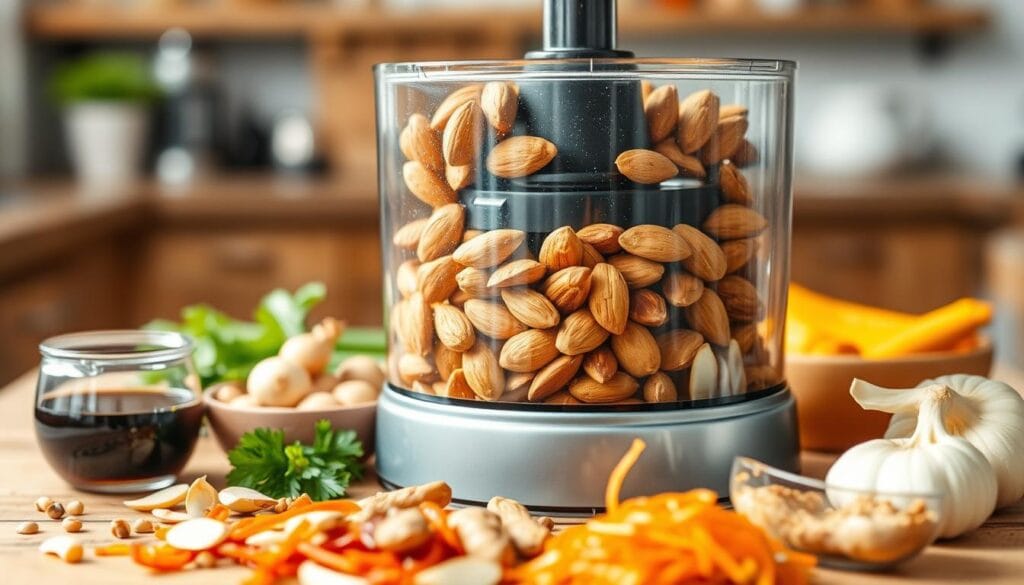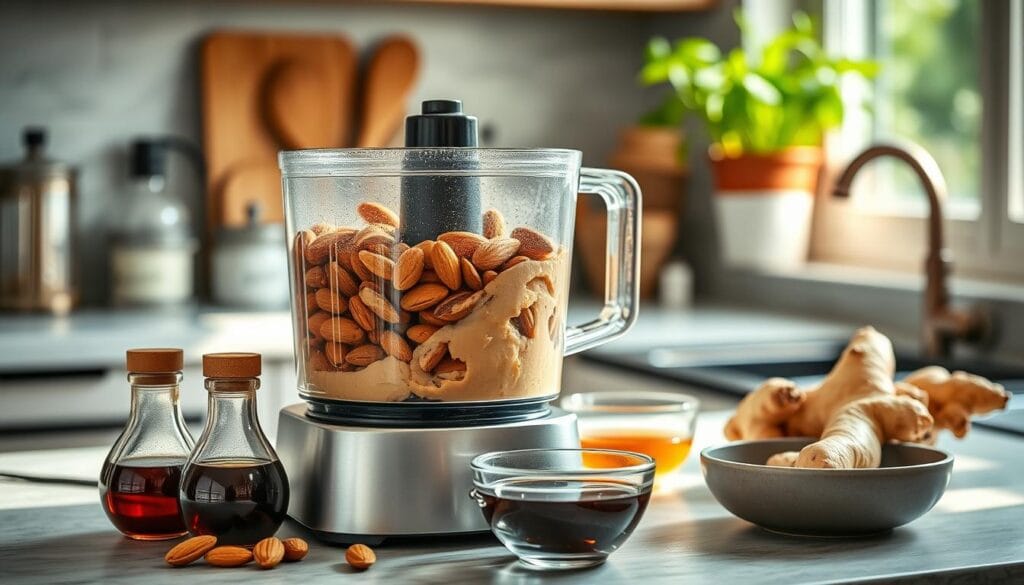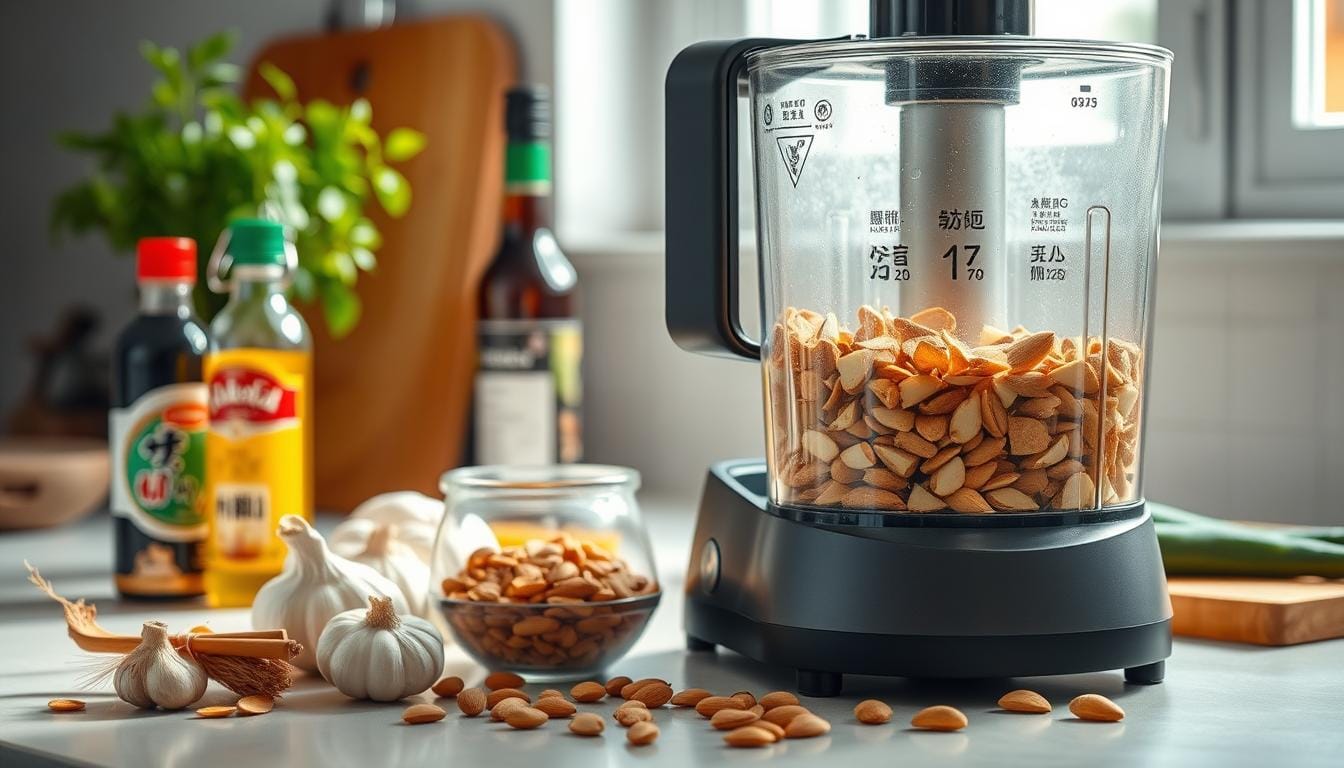Easy Food Processor Almonds and Asian Sauce Recipe
Imagine you’re craving a bold, flavorful sauce to make your weeknight meals better. But you don’t want to spend hours cooking. That’s where the quick almond-based Asian sauce comes in. It’s ready in just 15 minutes with your food processor.
This sauce is perfect for many dishes. It can turn noodle dishes, salads, and grain bowls into something special. Its nutty, savory taste is a game-changer.
Table of Contents
What Makes This Asian Almond Sauce Special
This Asian almond sauce is quick to make and packed with health benefits. It’s ready in just 15 minutes, perfect for busy days. You can use it in many ways, making it a great addition to your meals.
Quick and Effortless Preparation
This sauce is easy to make, thanks to a food processor. In just 15 minutes, you can have a batch ready. It’s simple, even for beginners.
Versatile Usage Options
This sauce is great for many things. Use it as a dip, dressing, or marinade. It’s perfect for rice bowls, spring rolls, or stir-fries.
Health-Conscious Choice
This sauce is healthier than many others. It has vegan nut butter for protein and healthy fats. Plus, it’s full of flavors like cashew ginger sauce and spicy peanut sauce.
Looking to make your meals better? This Asian almond sauce is a great choice. It’s easy to use, healthy, and full of flavor.
Essential Ingredients for Your Sauce
Making the perfect roasted almond recipe or Thai peanut sauce needs the right mix of ingredients. At the core is the almond, which can be raw or roasted for a deep, nutty taste. Soy sauce or tamari adds a savory umami flavor, while minced garlic and ginger bring a rich aroma.
A bit of rice vinegar adds a nice tang, and maple syrup or honey sweetens it. For more depth, try adding sesame oil. You can also swap almonds for cashew or sunflower seed butter to change the flavor.
Want more spice? Add chili paste, Sriracha, or a squeeze of lime juice. With these key ingredients, you’re ready to make a delicious Thai peanut sauce or roasted almond recipe.
| Ingredient | Purpose |
|---|---|
| Almonds (raw or roasted) | Provides nutty flavor and creamy texture |
| Soy sauce or tamari | Adds savory umami notes |
| Minced garlic and ginger | Enhances aroma and complexity |
| Rice vinegar | Contributes a subtle tanginess |
| Maple syrup or honey | Balances the flavors with sweetness |
| Sesame oil (optional) | Adds a nutty, aromatic layer |
This recipe is all about being flexible. Try different nut butters, change the spice, or make it fit your diet. The fun is in making it your own roasted almond recipe or Thai peanut sauce.
Food Processor Almonds and Asian Sauce Recipe
Equipment Needed
To make this tasty sauce, you’ll need a food processor or a high-powered blender. These tools ensure your sauce is smooth and creamy.
Base Ingredients List
- 1 cup raw almonds
- 2-3 tablespoons soy sauce
- 1 clove of garlic
- 1 teaspoon grated ginger
- 1 tablespoon rice vinegar
- 1 tablespoon sweetener (such as maple syrup or honey)
- 1/4 cup water or coconut milk
Optional Flavor Enhancers
- 1 teaspoon sesame oil
- 1 teaspoon chili paste or Sriracha
- 1 tablespoon fresh lime juice
This recipe makes about 1 cup of flavorful sauce, enough for 2-4 people. You can tweak the ingredients to match your taste and dietary needs.
Step-by-Step Preparation Guide
Making the perfect food processor almonds and asian sauce recipe is easy with this guide. Follow these steps to make this tasty and versatile sauce.
- Begin by toasting the almonds to boost their taste. Place them on a baking sheet and bake at 350°F for 5-7 minutes. Stir them a few times until they’re lightly golden.
- Put the toasted or raw almonds in your food processor. Pulse until they’re finely ground, like almond butter.
- Now, add the garlic, ginger, soy sauce, rice vinegar, honey, and sesame oil to the food processor. Blend until it’s smooth and creamy asian sauce.
- Adjust the sauce’s thickness by adding water or vegetable broth if needed. Taste and adjust the seasoning. Add more soy sauce, vinegar, or honey to get the flavor just right.
This recipe takes about 15 minutes to make. You’ll spend 10 minutes preparing and 5 minutes blending. It’s a quick way to make a delicious sauce that can enhance many dishes.
| Ingredient | Quantity |
|---|---|
| Almonds | 1 cup |
| Garlic cloves | 2 |
| Fresh ginger | 1 tablespoon |
| Soy sauce | 2 tablespoons |
| Rice vinegar | 2 tablespoons |
| Honey | 1 tablespoon |
| Sesame oil | 2 tablespoons |
| Water or vegetable broth | 1-2 tablespoons |

With this guide, you can make a delicious food processor almonds and asian sauce recipe. It’s perfect for enhancing many dishes. Enjoy making this flavorful sauce and let your creativity in the kitchen shine!
Customization Options and Variations
Make your vegan nut butter experience even better by trying different options and flavors. You can choose a creamier texture or a bolder taste. There are countless ways to make this cashew ginger sauce your own.
Nut Alternatives
You can swap almonds for other nuts like cashews, peanuts, or sunflower seeds. Each nut brings its own flavor, so try different ones to find your favorite.
Spice Level Adjustments
Change the spice level of your cashew ginger sauce to your liking. Add more chili paste or Sriracha for heat, or less for a milder taste. Start with a small amount and add more if you want it spicier.
Dietary Modifications
Make your recipe fit different diets by making simple changes. Use tamari for a gluten-free version, or omit sweeteners for a keto-friendly option. You can get creative with your vegan nut butter recipes.
Try making a spicy almond sauce, a citrusy almond sauce, or a creamy coconut almond sauce. The cashew ginger sauce is versatile, letting you explore new flavors and enjoy them.
Storage and Shelf Life Tips
To keep your almond butter recipe fresh and tasty, proper storage is crucial. Here are some tips to help your homemade Asian almond sauce stay fresh longer:
- Keep the sauce in an airtight container in the fridge for 5-7 days. This keeps its texture and taste just right.
- If you want to store it longer, freeze it for up to 3 months. Use small containers or ice cube trays for easy reheating.
- Using a condiment bottle or squeeze bottle makes it easy to use the sauce. It also helps avoid contamination from dipping.
By following these simple storage tips, your almond butter recipe-based Asian sauce will stay flavorful. It will be ready to enhance your meals for days or even months.

Nutritional Benefits and Values
This almond milk recipe is not just tasty but also full of good stuff. It’s loaded with healthy fats, protein, and fiber. These make it a great choice for a healthy meal.
Protein and Healthy Fats
Two tablespoons of this sauce give you 3 grams of protein and 6 grams of healthy fats. These fats are good for your heart and can lower the risk of heart disease.
Vitamins and Minerals
The almonds in this recipe are full of vitamin E. Vitamin E is great for your immune system and skin. This sauce also has magnesium, which is important for energy, muscles, and bones.
Dietary Considerations
This almond milk recipe has only 80 calories per 2 tablespoons. It’s perfect for vegans, gluten-free diets, and keto diets. It’s a healthy choice for many people.
| Nutrient | Value per 2 tbsp Serving |
|---|---|
| Calories | 80 |
| Protein | 3 g |
| Fat | 6 g |
| Carbohydrates | 4 g |
| Fiber | 1.5 g |
| Vitamin E | 25% DV |
Adding this almond milk sauce to your meals is a smart choice. It tastes great and is good for you too.
Serving Suggestions and Pairings
Discover the many uses of this asian dipping sauce and thai peanut sauce. Try it over noodle bowls for a flavor boost. Or, use it as a dip for spring rolls and veggie sticks. The options are endless!
This sauce is great with stir-fries, grain bowls, and roasted veggies. Brush it on grilled meats or as a spread for sandwiches and burgers. It opens up a world of creative cooking possibilities.
Whether you’re making Asian dishes or trying new fusion foods, this sauce will make your meals better. Its unique taste goes well with many foods, making it a key item in your kitchen.
Serving Suggestions:
- Noodle bowls
- Spring rolls and veggie sticks
- Stir-fries
- Grain bowls
- Roasted vegetables
- Wraps and sandwiches
- Burgers
Flavor Pairings:
- Asian-inspired dishes
- Fusion cuisines
- Grilled proteins
- Rice, quinoa, and other grains
- Fresh herbs and citrus
Let the bold flavors of this asian dipping sauce and thai peanut sauce take your cooking to the next level. It’s perfect for noodle dishes and veggie meals. Your taste buds and guests will love it.
Expert Tips for Perfect Consistency
Getting the perfect consistency is crucial for your food processor almonds and asian sauce recipe. Here are some expert tips to help you achieve a smooth and creamy texture:
- Add liquid ingredients slowly while blending. This slow addition helps the sauce mix well and reach the right consistency.
- Use a high-powered food processor or blender for the best results. Their strong motors and sharp blades break down the almonds and other ingredients well.
- Soak the almonds overnight before blending. This makes them softer, leading to a creamier sauce.
- Stop the blending occasionally to cool the motor. This prevents the sauce from getting too thick or grainy.
- Soak the processor bowl in water right after use for easy cleaning. A bit of baking soda can help remove tough spots.
By using these expert tips, you’ll make a food processor almonds and asian sauce that’s silky-smooth every time.
Common Troubleshooting Solutions
Perfecting your almond butter recipe or asian marinade is easier than you think. If your sauce is too thick, add a little water or coconut milk. This will help you get the right consistency. On the other hand, if it’s too thin, add more almond butter or less liquid.
Is your sauce too spicy? Just add a bit more honey or maple syrup to balance it out. For a smoother sauce, blend it longer or use blanched almonds instead of raw ones.
- Adjust the thickness by adding water or coconut milk (for a thinner sauce) or increasing almond butter (for a thicker consistency)
- Tone down the spice level by incorporating more sweetener
- Achieve a silkier texture by blending for longer or using blanched almonds
- Enhance the flavors by adding more soy sauce for saltiness or vinegar for tanginess
Homemade sauces are all about making them your own. Feel free to try new things and find the perfect mix of flavors and textures. With a bit of practice, you’ll be making amazing asian marinade in no time.
| Troubleshooting Issue | Solution |
|---|---|
| Sauce is too thick | Add water or coconut milk slowly |
| Sauce is too thin | Increase almond butter or reduce liquid |
| Sauce is too spicy | Add more sweetener |
| Sauce has a grainy texture | Blend for longer or use blanched almonds |
| Sauce needs more flavor | Adjust soy sauce for saltiness or vinegar for tanginess |
“The beauty of homemade sauces lies in their customizability. Don’t be afraid to experiment and find the perfect balance of flavors and textures that suit your tastes.”
Conclusion
This food processor almonds and Asian sauce recipe is a great addition to your cooking. It’s quick to make, fits many diets, and tastes amazing. It’s perfect for both new and seasoned cooks.
Using a food processor makes the almonds smooth and creamy. This creates a tasty Asian sauce that goes well with many foods. You can also change the recipe to fit your taste, like adding more spice or using different nuts.
Adding this recipe to your meals makes them taste better and is good for you. It’s packed with protein, healthy fats, and vitamins. This recipe is a must-try for a delicious and nutritious meal.






